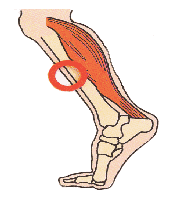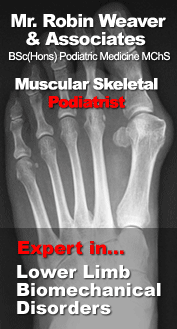 Anterior Shin Splints
Anterior Shin Splints
 ‘Shin
Splints’ is a term often used to describe exercise
-induced stress reactions upon structures in the lower leg.
These structures include bone, muscle, tendon and connective
tissue. Shin splints are generally associated with over-use. ‘Shin
Splints’ is a term often used to describe exercise
-induced stress reactions upon structures in the lower leg.
These structures include bone, muscle, tendon and connective
tissue. Shin splints are generally associated with over-use.
The resultant swelling and inflammation of the affected
structures places increased pressure on nerve endings, causing
a dull aching pain localized to the front of the shin bone,
and can progress to intense aching even during walking.
The most frequently affected site for runners is where the
anterior tibial muscles anchor into the lower front third
of the shin bone. These muscles function as decelerators of
the foot at heel strike, and can be overused during unaccustomed
downhill running, running on hard surfaces or over-striding.
As well as decelerating foot slap at heel strike, the anterior
tibial muscles counter excess pronatory forces; consequently
runners with pronated feet stress the anterior tibial muscles
far more than neutral runners, and are more prone to shin splints.
What can you do to prevent shin
splints?
- Use the right trainer for your foot type; if you are
a pronator, supinator or neutral runner you will reduce
your chances of developing splints by wearing the correct
trainer type. Never run in worn-out trainers. If you are
in doubt as to what trainer type you require, see a
Podiatrist.
- Sudden increases in mileage can trigger shin splints,
so increase your mileage by no more than ten percent per
week. Harder running sessions such as interval work or hill
running also need to be introduced with care. Rest days
must be incorporated into the running programme, when high
intensity sessions are being undertaken.
- Use a prefabricated pronation control orthotic such as the Orthosport Activ-8 ™ orthotic, a perfect choice for moderate over pronators
If you experience shin splints what
should you do?
- Immediately after completing a run, ice the affected area
for 15 minutes, repeating two to three times per day.
- As with all overuse injuries rest is the best intervention,
so take a few days off.
- Consult your pharmacist about oral anti-inflammatory
medication; gels tend to be poorly absorbed and ineffective.
- If you have had the splint for more than six weeks or
you suffer from recurrent shin splints it is likely that
you have a biomechanical problem that will require careful
diagnosis and management by a State Registered Podiatrist.
What treatments are available?
Our prefabricated orthotics are ideal for trating shin splints.
More info...
Buy now...
|

